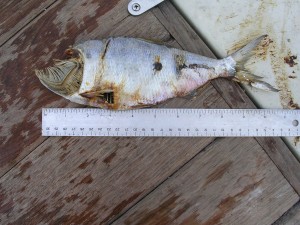Osprey and menhaden in Chesapeake Bay
CCB Bulletin to Birders: Request for assistance in locating marked birds
October 18, 2008Historic database of bank-dependent birds in Chesapeake Bay
January 2, 2009
Written by Bryan Watts
January 1, 2009

Osprey chick near fledging age. Photo by Bryan Watts.
The Chesapeake Bay is the largest estuary in the United States, containing more than 19,000 km of tidal shoreline. The Bay’s wide salinity gradient, shallow water and climate have made it one of the most productive aquatic ecosystems in the world. The diverse fish community has been the basis of significant commercial fisheries for centuries. Currently, the take of menhaden in the Bay is the largest commercial fishery along the Atlantic Coast. In addition to its commercial value, the menhaden population is important to many populations of piscivorous birds. The Chesapeake Bay supports the largest osprey breeding population in the world and along the main stem of the Bay, pairs appear to depend on menhaden stocks.
Three generations of William & Mary graduate students have worked with osprey within the Mobjack Bay (an important sub-estuary within the lower Chesapeake Bay) study area: Chris Stinson (1976), Peter McLean (1986) and Andy Glass (2007). Collectively, these research projects have demonstrated the dependence of breeding osprey on menhaden and how falling stocks are impacting provisioning rates and reproductive success.

Young osprey chicks individually marked for growth study. Photo by Andy Glass.
During the 2006 and 2007 breeding seasons, Andy Glass showed that reproductive rates within Mobjack Bay had declined to levels not seen since the height of the DDT era in the early 1970s. However, unlike during that time period, hatching rate was greater than 90%. Productivity was being suppressed by chick loss during the early brooding period. Provisioning rates documented by Stinson in the mid-1970s were more than 1900 g/d. By the mid-1980s, McLean documented that provisioning rates had declined to 850 g/d. By 2006, Glass documented that provisioning rates had dropped further to below 700 g/d. In addition between the mid-1980s and 2006, the overall energy density of the diet had declined by 25%. Osprey were providing less food of lower quality to broods.

Menhaden from an osprey nest on Mobjack Bay – The use of menhaden by osprey has dropped dramatically in the past 20 years likely reflecting changes in available stock. Photo by Andy Glass.

Andy Glass weighing an osprey chick as part of a study of the influence of salinity on growth rates. Andy’s study included many broods spanning a broad salinity gradient. The study examined diet, provisioning rates, and chick growth. Photo by Bryan Watts.
In the 20 years between the McLean and Glass studies, the importance of menhaden in the diet declined from more than 70% to below 27%. Menhaden stocks have declined by more than 90% since the mid-1970s when Stinson studied osprey ecology in Mobjack Bay. In the main stem of the Chesapeake Bay, menhaden appears to be a component of the diet that is not replaceable. What stocks are required to sustain a reproductively viable breeding population of osprey in the main stem of the Bay remains an important question.
Funding for this project provided by The Center for Conservation Biology (CCB).



